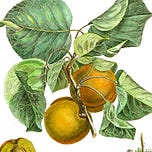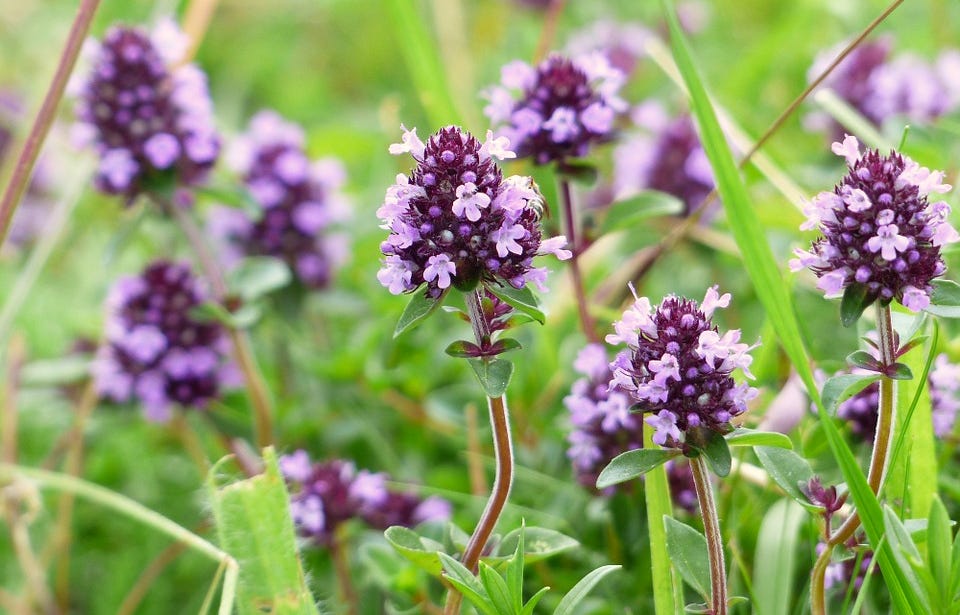Along with rosemary and sage, thyme is considered one of the ‘holy trinity’ of aromatic herbs, and like them it comes from the same family, Lamiaceae. It is found in abundance not only on the exposed rocky landscapes of the Mediterranean, but also in the literature of the classical world.
In his handbook on agriculture, Georgics, the great Roman poet Virgil talks about bees producing ‘thymo fragrantia mella’, honey fragrant with thyme; and it seems that the herb was also a key ingredient of religious rituals. 1
Thyme gives off a powerful fragrance when burnt, and the Greek word θυμός (thumós) meaning ‘soul’ or ‘breath’, can also mean smoke (Latin fumus is a direct descendant). The strong connection between these ideas has led some classicists to the conclusion that the word may even be related to θύω (thuo) the Greek word for to sacrifice or kill. 2
Incidentally, the ‘thymus’ gland, which plays such a significant role in the development of a child’s immune system, is so-called either because it was once considered the seat of the soul, or because its shape was thought to resemble a bud of wild thyme.
An early blogger
Had he been alive today, Saint Isidore of Seville might well have taken out a subscription to Roots and Fruits. Isidore was responsible for the greatest encylopedia of the natural world since the work of Pliny the Elder. What’s more, many of the entries in his 20-volume masterpiece concerned the origins of the names of plants.
Not all of Isidore’s histories are reliable, but one which appears to be is a reference to an ancient name for thyme: ‘matris animula’ or ‘soul of the mother’. It seems that the leaves and flowers of the low-lying shrub were recommended for menstrual pain, and as a ‘comforter of the womb’.
The name is preserved in Czech mateřídouška, Slovak materina dúška and Croatian majčina dušica — all of which combine a word for mother and the diminutive of the word for ‘soul’ — as well as Polish macierzanka and Bulgarian мащерка (mashcherka).
Isidore tells us that this name is used for wild, or ‘creeping’ thyme Thymus serpillum, so-called because ‘its roots creep afar’ (‘radices… serpant longe’). 3
A savoury from the East
It should be noted that names of the mateřídouška type are commonly used to refer to a wide variety of ‘thymes’. For the thyme usually found in the kitchen, Thymus vulgaris, the languages above tend to use something more like English ‘thyme’: tymián in Czech and Slovak, tymianek in Polish, and so on.
In Arabic-speaking countries, the word is زَعْتَر (za’atar). But in rather the same way, za’atar is pretty fluid; it can refer to thyme alone, or to a wider family of herbs, or else to a popular spice mixture of thyme with hyssop, sumac, and sesame.4
The name za’atar is the probable source of the Latin satureia, from which, via Old English sæþerie, we arrive at the present-day savoury. This herb, closely related to thyme, is used in a wide variety of culinary applications, from France (where it forms the basis of herbes de Provence) to the Balkans where it provides fragrance for sarma, or stuffed cabbage rolls, a kind of dolmades. 5
Sober and grave?
This concludes our midwinter trip to the herb garden. The four plants we’ve looked at — parsley, sage, rosemary and thyme — famously make up the chorus of the folk-song Scarborough Fair.
Sometimes known as ‘The Elfin Knight’ or ‘The Cambric Shirt’, the song is structured around a sequence of paradoxical or impossible tasks which must be solved before the singer can call his loved one ‘true’. In one way it’s an admission of defeat before the courtship has even begun. Humans are frail, and even with all the time in the world can never hold on to what they have.
The Simon and Garfunkel version, featured in The Graduate (1968) is the most familiar, but its history is very much older. Like all such songs, whose lyrics were not recorded but handed down by oral tradition, mistakes and variations could creep in. One version, for example, substitutes ‘savoury’ for ‘parsley’: ‘Savoury, sage, rosemary and thyme’. And another, intriguingly, suggests that the entire chorus of herbs may be a misinterpretation of a very different, and perhaps more optimistic message:
‘Are you going to Scarborough Fair?
Sober and grave grows merry in time.’
Many editions of the Georgics are available online. Here is a good translation https://www.poetryintranslation.com/PITBR/Latin/VirgilGeorgicsIV.php;
and here is the original Latin text at Tufts University http://www.perseus.tufts.edu/hopper/text?doc=Perseus%3Atext%3A1999.02.0059%3Abook%3D4%3Acard%3D1
‘Thumos’ at Wiktionary https://en.wiktionary.org/wiki/%CE%B8%CF%85%CE%BC%CF%8C%CF%82
Etymologiae Isidoris Royal MS 6 C I f140r (British Library).
An eleventh-century manuscript of the Etymologiae can be browsed at http://www.bl.uk/manuscripts/Viewer.aspx?ref=royal_ms_6_c_i_f003v.
‘Za’atar’ at Wikipedia
https://en.wikipedia.org/wiki/Za%27atar
‘Savory’ at https://www.etymonline.com/word/savory?ref=etymonline_crossreference















Share this post